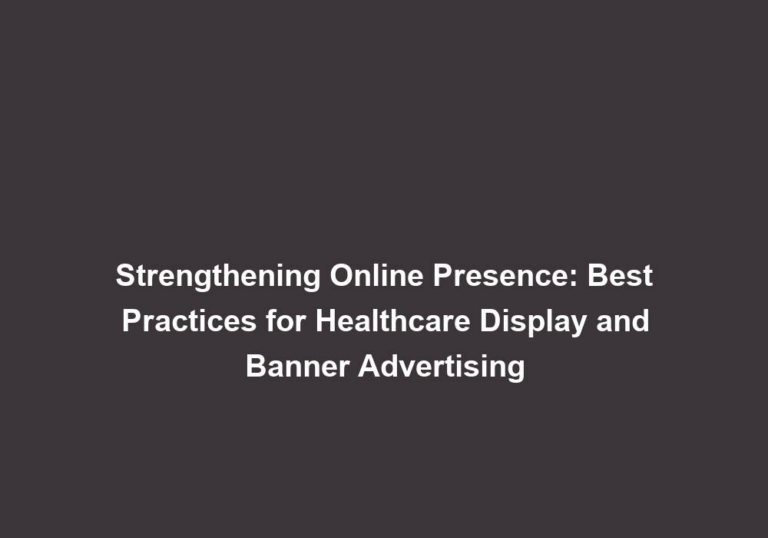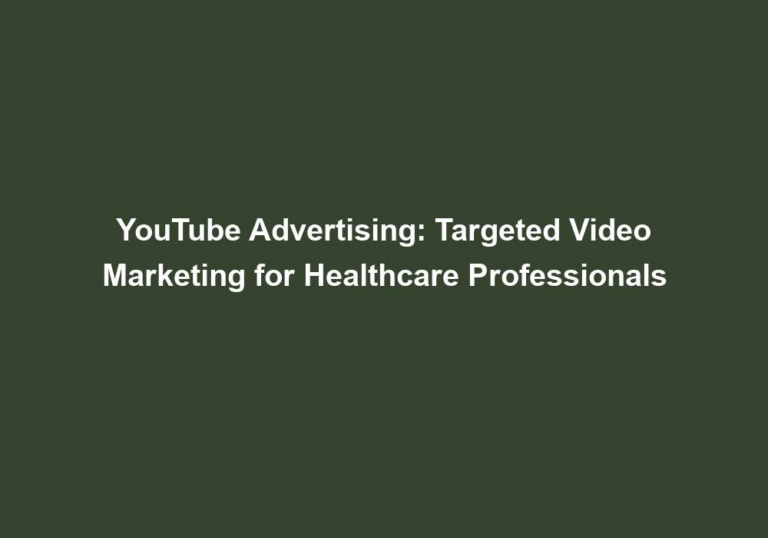Navigating Online Advertising: Social Media Strategies for Healthcare
In today’s digital era, online advertising has become an essential tool for healthcare organizations to effectively reach their target audience. With the rise of social media platforms, healthcare providers can now leverage these channels to engage with patients, raise awareness about their services, and build a strong online presence. This article will delve into the strategies and best practices for healthcare organizations to navigate the realm of online advertising through social media platforms.
The Importance of Social Media in Healthcare Advertising
Social media platforms have transformed the way people communicate and interact with each other. It has also revolutionized the way businesses, including healthcare providers, market their products and services. Here are some key reasons why social media is crucial for healthcare advertising:
-
Enhancing brand visibility: By leveraging social media, healthcare organizations can increase their brand visibility and reach a wider audience. It allows them to showcase their expertise, services, and unique value proposition to potential patients. Through consistent and engaging content, healthcare providers can establish themselves as trustworthy and reliable sources of information, ultimately boosting their brand visibility.
-
Building trust and credibility: Establishing trust is imperative for healthcare providers. Social media offers an opportunity to share helpful and authoritative content, showcase patient testimonials, and interact directly with patients, thereby enhancing credibility and building trust. By providing accurate and reliable information, healthcare organizations can position themselves as industry leaders and gain the trust of their target audience.
-
Targeting specific demographics: Social media platforms provide advanced targeting options that allow healthcare organizations to reach their intended audience accurately. Whether it’s targeting specific age groups, geographic locations, or interests, social media advertising enables precise targeting to maximize the return on investment. By tailoring content and advertisements to specific demographics, healthcare providers can ensure that their message reaches the right people at the right time.
-
Engaging with patients: Social media platforms enable healthcare providers to engage and communicate with patients in real-time. It allows for personalized interactions, answering inquiries, and sharing educational content, fostering a sense of community and patient loyalty. By actively engaging with patients through comments, direct messages, and live chats, healthcare organizations can build meaningful relationships and provide valuable support to their audience.
Key Strategies for Effective Social Media Advertising in Healthcare
To make the most out of social media advertising, healthcare organizations should implement the following strategies:
1. Define Your Target Audience
The first step in any successful advertising campaign is identifying your target audience. Clearly defining your audience allows you to tailor your content and messages to their specific needs and preferences. Consider factors such as age, gender, geographic location, interests, and health concerns to create targeted and relevant content that resonates with your audience.
- Conduct thorough market research to understand the demographics and psychographics of your target audience.
- Create buyer personas to represent different segments of your target audience.
- Use social media analytics tools to gather data on your audience’s online behavior and preferences.
- Continuously refine and update your target audience as you gather more insights.
2. Choose the Right Social Media Platforms
There are several social media platforms available, each with its own audience and purpose. It’s important to understand which platforms are most suitable for reaching your target audience. For instance, Facebook and Instagram are popular platforms for healthcare advertising due to their broad user base and robust targeting options. LinkedIn, on the other hand, is more focused on professional networking and can be useful for targeting healthcare professionals and business-to-business interactions.
- Research the demographics and user behavior of different social media platforms.
- Identify the platforms where your target audience is most active.
- Consider the specific features and advertising options offered by each platform.
- Develop a comprehensive social media strategy that encompasses multiple platforms for maximum reach.
3. Create Engaging and Educational Content
Social media advertising should not be solely focused on promotion and sales. Instead, aim to create content that educates, informs, and engages your audience. Share valuable insights, expert opinions, patient success stories, and health tips that are relevant to your target audience. It’s crucial to strike a balance between promotional content and genuinely helpful information to build a loyal following and establish thought leadership in the industry.
- Conduct keyword research to identify popular topics and search queries in your industry.
- Develop a content calendar to ensure a consistent flow of engaging content.
- Use storytelling techniques to make your content more relatable and memorable.
- Encourage user-generated content by asking for feedback, reviews, and testimonials.
4. Utilize Visual Content
Visual content has proven to be more appealing and engaging than text-based content. Incorporate visually appealing images, infographics, videos, and animations into your social media advertising strategy. Visual content not only captures attention but also effectively conveys complex information in a digestible format.
- Hire professional designers or use design tools to create visually stunning graphics.
- Experiment with different types of visual content, such as videos and live streams.
- Optimize visual content for different social media platforms to ensure optimal display.
- Use captions and descriptions to provide context and accessibility for visually impaired users.
5. Leverage Influencer Marketing
Influencer marketing has gained immense popularity in recent years. Collaborating with influencers, who have a significant following and credibility in the healthcare industry, can amplify your brand’s reach and credibility. Identify influencers relevant to your niche and engage them to promote your services or products through sponsored content or partnerships.
- Research and identify influencers who align with your brand values and target audience.
- Reach out to influencers with a personalized and compelling pitch.
- Set clear goals and expectations for the influencer collaboration.
- Monitor and measure the impact of influencer campaigns through referral traffic and engagement metrics.
6. Monitor and Analyze Performance
Regularly monitoring and analyzing the performance of your social media advertising efforts is crucial to optimize results. Utilize analytics tools provided by social media platforms to track key metrics such as reach, engagement, click-through rates, and conversions. Analyze the data to identify trends, understand what works best for your audience, and make data-driven decisions to improve your campaigns.
- Set up tracking pixels and conversion goals to measure the effectiveness of your campaigns.
- Conduct A/B testing to compare different ad formats, messaging, and targeting strategies.
- Monitor audience sentiment and feedback through comments and direct messages.
- Use social listening tools to stay updated on industry trends and competitor strategies.
7. Stay Compliant with Regulations
Lastly, healthcare organizations must adhere to strict regulations and guidelines, such as HIPAA (Health Insurance Portability and Accountability Act), when engaging in social media advertising. Ensure that your content, patient interactions, and data collection practices comply with the relevant regulations to maintain patient privacy and confidentiality.
- Familiarize yourself with the regulations and guidelines specific to your region and industry.
- Train your social media team on HIPAA compliance and data security best practices.
- Implement secure data collection and storage systems to protect patient information.
- Regularly audit and review your social media advertising practices to ensure compliance.
In conclusion, social media has become an indispensable tool for healthcare organizations to navigate the realm of online advertising effectively. By implementing the strategies outlined above and staying up-to-date with the latest industry trends, healthcare providers can leverage social media platforms to enhance brand visibility, engage with patients, and achieve their marketing objectives. Embrace the power of social media advertising and revolutionize your healthcare marketing efforts today.







